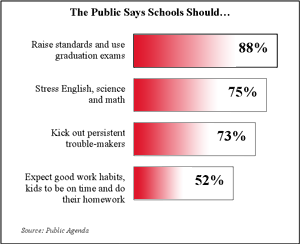The Challenge: To establish a clear set of expectations that schools, teachers and students should achieve in critically important subjects.
The Solution: Require each state to establish its own standards of what students should know and be able to do in the core content subjects—reading, math and science.
HOW STANDARDS IMPROVE EDUCATION

Standards have gone from controversy to necessity. Americans now support higher academic standards in record numbers.
Americans understand standards are the road map to reform. They provide guideposts for academic achievement. They clearly tell students and parents where they are going.
No Child Left Behind requires each state to establish its own unique set of standards for reading, math and science.
- Taxpayer dollars will only go to states that have standards and expectations for improving schools or teaching a solid academic curriculum.
- Under No Child Left Behind states are required to establish their own annual tests aligned with state standards for grades three through eight to measure how successfully students are learning what is expected by the standards.
Standards help direct schools toward common academic goals and unite the community for reform and achievement.
- Standards help set a high academic bar for selection of textbooks, lesson plans and teacher preparation.
- Accountability systems gather specific, objective data through tests aligned with standards. This information is used to identify strengths and weaknesses in the system.
- They help schools focus resources on the best way to promote learning and help parents track their child's progress.
No Child Left Behind gives states flexibility.
- There are no national standards.
- States design their own standards and their own tests.
The Resources: No Child Left Behind, which became law in early 2002, increased federal education funding to more than $22.1 billion for America's elementary and secondary schools—a 27 percent increase over 2001, and a 49 percent increase over 2000 levels.
Download this fact sheet. (It is in PDF format.)
Back to Top | Return to What to Know | Read Next Article
| 


